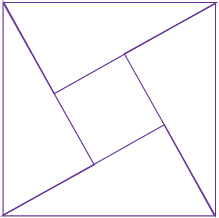| Pythagoras
was a Greek mathematician (about 580–500 BC) who
formed a secret society based partly on mathematical discoveries.
The motto of his followers is said to have been "All
is number."
What is called the Pythagorean
Theorem was known to the Egyptians as early
as 2000 BC and to
the Babylonians in 1700 BC.
The Hindu mathematician
Bhaskara (about 1114-1185) proved the Pythagorean
Theorem simply by drawing this picture and saying “Behold!”

|

|
Lewis
Carroll, author of Alice in Wonderland, and
US President James
Garfield wrote proofs of the Pythagorean Theorem.
French mathematician Pierre
Fermat (1601–1665) built on the Pythagorean
Theorem by proving that no cube is the sum of two cubes
and no fourth power is the sum of two fourth powers. He
believed that the same was true for all whole-number powers
greater than 2. He wrote in the margin of a notebook that
he had a proof of his belief, but the margin was too small
for the proof. Only in 1995,
more than 300 years later, did British-born
mathematician Andrew Wiles find the key that
proved Fermat correct.
Choose any two different positive counting numbers a
and b with a the bigger of the two. If
-
x = 2ab,
-
y = a2 - b2, and
-
z = a2 + b2;
then x, y, and z form a Pythagorean
triple. |
